You’ll find links to previous guest posts in this series here.
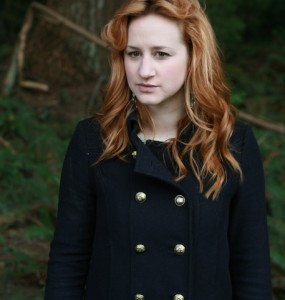
MEGHAN LATTA studied art at Emily Carr University of Art + Design, and lives and works in Vancouver, British Columbia, where she pursues writing and illustration in her spare time.
My treasures:
1.
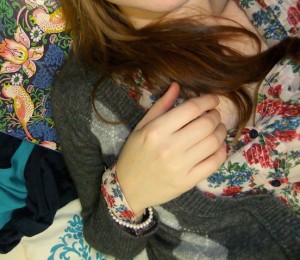 I buy interview clothes and wear them all day as I walk across Dublin, the cobbles of Temple Bar slowing my step. After dropping off resumés and wandering the streets looking for Help Wanted signs, I sit in coffee shops for hours. I sit and draw faces over and over, thinking about love and distance.
I buy interview clothes and wear them all day as I walk across Dublin, the cobbles of Temple Bar slowing my step. After dropping off resumés and wandering the streets looking for Help Wanted signs, I sit in coffee shops for hours. I sit and draw faces over and over, thinking about love and distance.
I go to the gallery and think about being deliberate, about choosing one thing over all others, committed enough that the bare bulbs above your head don’t matter. I see the artist’s studio meticulously reconstructed and glassed off like a zoo habitat. An exotic animal.
As I walk back to the flat, the rain starts suddenly, and then all the air is grey with it and everyone moves faster on the sidewalks, or crowds under overhangs, looking, turning, hands in pockets.
From my window later I watch the birds wheeling and wheeling over the city rooftops. The window mostly looks out at a wall and the low cigarette-and water-filled rooftop of another flat. Then I lie in bed and look through the small gap in the curtains hoping to see anything else. I would like the flowers (the tiny red roses and green leaves) to leak from my shirt and cover the land.
The shirt finally becomes unwearable many months later; in a hotel bathroom in France I hear it rip for the second time. I take it off, and hover over the garbage holding it, looking at the rose pattern that was a strange kind of comfort in the cold and colourlessness of Dublin.
I don’t keep much; on this trip especially I have gotten good at throwing things to the wind. I tear the fabric more, separating off a small square that I pack away in the bottom of my bag.
2.
I have many sweaters to ward off the constant cold of Ireland. One of them I wear because it reflects my mood. The rearing red animals. In a row, mouths open, front legs flailing. Roaring on the deep blue wool background. A heart is like a cricket trapped in a sweater (I’ve said this before).
I talk to friends on Skype and they keep asking, “Why don’t you just leave?” And I explain again about my stolen passport, my wish to find a job, in spite of the warning of the border guard when I entered this country — less a warning than a puzzled laugh — “You want work … here?”
In the meantime I have chewed all my fingernails off.
He was reading Margaret Atwood in one of the coffee shops I spent far too much time in, and later, while we were walking, he asked me what I would do to the Millennium Spire — that needle to the sky in the middle of Dublin. I said, “Put a giant disco ball on the tip and shine a laser at it.”
I told myself, I will not pull on the threads of your sweater. I will not tie you to me.
The cowardly lion stutters, C-c-courage.
I was only going to draw his mouth, and the rest of the face followed. The lines have their own logic. To draw someone is to follow the curve of their lips and the angle of their nose, and this closeness is a dangerous thing. If you draw them you are doomed. You are doomed anyway. If you have no photographs, you find proxies.
I want to tell him about Canada: the jesus ducks, the ice coating the inside of the bus window, the way flax looks like a sky. The blithe white butterflies, the exorcism in falling rain in her backyard, the deer twitching in the twilight fields, their tails a bright flag. His sweater reveals the thinness of his arms; we could be a white-on-white painting.
The red of my hair out-brights my shirt. I feel a flashpoint, the animals on my sweater too loud.
3.
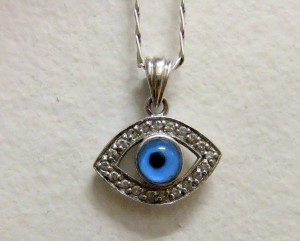 I hold up the eye, a pendant without a chain.
I hold up the eye, a pendant without a chain.
Dublin seems like a bad dream, the wasted nights spent unrestful, running many miles to nowhere in sleep, and now, sitting on a terrace, the ocean just there, everything made of the same pale stone. The green light of the beer bottle spills across the page.
The only real souvenir I buy is from Malta, in a shop at the end of a line of white stone leading from the seaside temples to the Blue Grotto. The Grotto is a cleft in the Maltese shore where the beating water has formed an underwater cave, and the tourists go there now in boats and stare up at a cathedral of hollowed stone. Disappearing into blue. The myth of paradise.
There are saints by all the doors. My shadow lies over the ocean and the worn stone pier. Spirit eyes stare from the ships in the harbour, vivid against the water. If I had a god, I would find it here; if I had a lover, I would take him to this place; if I had an army, we would rest here and let our horses drink.
4.
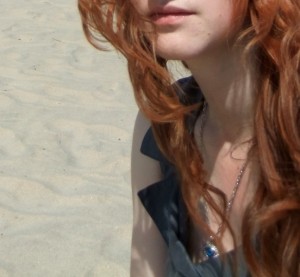 I am like a scarf loosed on the wind. Oporto, Portugal. Finally I have found the warm sun. Walking the surf’s edge, my feet in the cold water, I feel the sun burning my chest, the wind tangling my hair. I smell the saltfish and burning sugar, gaze out at blue on blue, then down at my own white flesh on the sand, thinking of the white-on-white painting we never made.
I am like a scarf loosed on the wind. Oporto, Portugal. Finally I have found the warm sun. Walking the surf’s edge, my feet in the cold water, I feel the sun burning my chest, the wind tangling my hair. I smell the saltfish and burning sugar, gaze out at blue on blue, then down at my own white flesh on the sand, thinking of the white-on-white painting we never made.
The nuns blown onto the shore like seabirds. The old men playing cards with stones to weigh them down. My feet follow the tide line, in and out of the water, stepping over jellyfish fragments. The eye around my neck stares out at the ocean, as it is meant to, its eyelids ridged with diamonds; it knows not to blink. The ocean stares back and cannot blink either.
I take one white stone from the beach and put it in my pocket.
5.
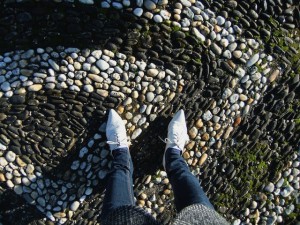 In a restaurant in Florence, Italy, the cook and I watch Mr. Bean on the television. He looks up often from the pasta carbonara he is preparing to watch. The comedy needs no words, and the cook and I have very few words between us.
In a restaurant in Florence, Italy, the cook and I watch Mr. Bean on the television. He looks up often from the pasta carbonara he is preparing to watch. The comedy needs no words, and the cook and I have very few words between us.
A man behind me, maybe the owner, asks me if I am English, which I take to mean English speaking, and I say, “Yes, how did you know?”
“Your shoes, they are very English.”
I laugh and say I bought them in Ireland, so yes, they are “English,” and how well he knows shoes.
6.
Ireland is still cold and wet when I return after four and a half months travelling. Though it is not true that there are no trees in Dublin — as someone once told me — their leaves are small and faint.
Once again clouds hang over the city. I collect my suitcase, stored at the home of a distant friend of a friend, and take the bus back from a neighbourhood filled with children, big brick houses and stained glass. As I look back, the god rays are shooting out over the top of the cloud. In the distance, veiled and almost erased, are the two small-breasted mountains. Beside the road the sandpipers peck and bob along the tide flats.
I don’t have many clothes here, I tossed most of them along the way, and so I buy a light seasonal cardigan. I like the stripes; they are coloured like America, blue and white shot through with bands of red.
I have written him an email saying I am only in town for a few days and then I am returning to Canada. I walk into the restaurant of a fancy hotel downtown and he walks in too, and he could not see my face because of the umbrella pulled down so low against the torrents of rain, but he says that in the lobby he recognized my shoes.
We sit together wrapped in my coat that smells of fire. He says something about finding a loose thread on my cardigan and pulling until it was gone. Sometimes things do happen this way, from the page to his mouth.
7.
The Dublin terminal looks like science fiction. The tiles shiny and sparkling, the shoes of the guards as they pass just as polished, moving black. He makes a few jokes so I won’t cry, and we sit shoulder to shoulder, waiting.
I run the gauntlet, buy chocolate bars we don’t have in Canada from the vending machines, drop my passport and don’t notice until a stranger hands it to me, and then stare out the airport window at the field of roads leading to no place, hearing my own accent for what feels like the first time out of the mouths of others.
When I make myself look back at the gate, he is gone, and a nun’s head glares at me over a low wall.
I get on a plane.
I can’t tell how much time has passed, now that I am moving back through it from the future, following the sun circuit over the earth. In the plane the electronic map shows us where we are, and how cold the air is.
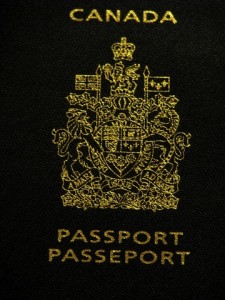
Note from Allyson: Meghan is my niece and also the artist who created the painting from which I chose the detail in my website banner — of a little girl in a garden. The little girl is me, and Meghan’s painting is of a photograph she liked that was taken years ago in the backyard of my childhood home. Hanging now in my dining room, her painting is one of my treasures.
Next in the series: watch for author Diane Schoemperlen’s “Seven Treasures.”
Meghan,
Your writing makes me realize how courageous you are at a young age. You are in touch with your feelings and observant of what is around you and how it affects you – and you are writing about it. When I was your age, I was swimming in the shallow end, but you dove into the ocean. Your poetic imagery awakens me to what it was like to be young, to have new experiences. Your writing has lovely texture and colour and longing. Other than your red hair, you don’t describe yourself, but I see you clearly from your observations and sentiments. That’s a gift.
I love this – so full of wonderful images of loss and longing and possibility.